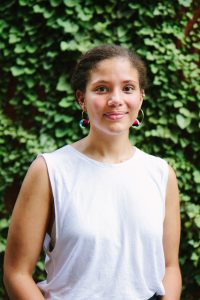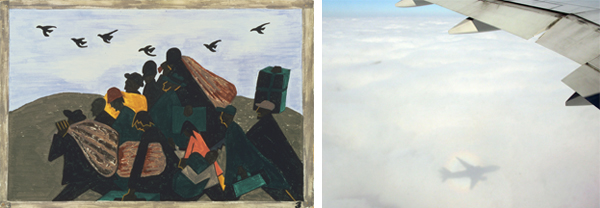In this series, Manager of Visitor and Family Engagement Emily Bray highlights participants in the 2017 James McLaughlin Memorial Staff Show, on view through September 17, 2017.

Alanna Reeves, “Picking”

Alanna Reeves. Photo: Rhiannon Newman
What do you do at The Phillips Collection? Are there any unique or interesting parts about your job that most people might not know about?
I work as a Museum Assistant within The Phillips Collection. My favorite job perk is access to the museum’s library. I love to do research via books and it’s an amazing collection of artist biographies and material study.
Who is your favorite artist in the collection?
I’m really enamored with Milton Avery. His works are very quiet and playful. After being part of the Phillips community for only a few months, I could see that his loose application of paint was beginning to influence aspects of my work. I see it contrast heavily with influences of Jacob Lawrence as well.
What is your favorite space within The Phillips Collection?
I love the rooms in the original Phillips house. Particularly, I am interested in the way contemporary artists have used the rooms for Intersection exhibitions. There are a lot of nooks and crannies to experiment with and I have found the rooms to be completely transformed into new environments when these artists pair their own work with that of works from the collection. I also appreciate that the Phillips has maintained these older spaces with their original architecture and can’t wait for them to reopen following the building enhancement.
What would you like people to know about your artwork on view in the 2017 Staff Show (or your work in general)?
This piece is one that I created after a trip to Jamaica, the birthplace of my paternal grandmother. I hadn’t been there in over a decade and it was an important return trip for me as I’ve recently been exploring ways in which hyphen-Americans regard and idealize their homelands. For me, Jamaica and my relation to it is an essential part of my identity and yet I am displaced from it, physically and otherwise. I try to reflect on ways my American identity affects my experience in Jamaica and how I can be a responsible visitor in a country that has a complex relationship in terms of its tourist economy. My piece Picking is an example of an idealistic environment and the instantaneous actions that occur within that space.
About the artist
Alanna Reeves was born in Washington, D.C., 1993. She is a recent graduate of the Rhode Island School of Design where she earned a BFA in Illustration and concentration in History of Art and Visual Culture. During her time there she participated in the institution’s European Honors Program. This semester-long program offers students who feel they have exhausted the pre-established curriculum the opportunity to conduct independent studio projects, all while in the heart of Rome, Italy. This study resulted in an intense focus on language, cultural perception, and origin. Having returned to her hometown, Reeves now engages with the District’s artist community via education and art administration with a particular interest in the non-profit sector. She currently serves as founder and editor of HUE: Culture, Color, Theory zine which has been accepted into university special collections.
The 2017 James McLaughlin Memorial Staff Show is on view August 3 through September 17, 2017.

